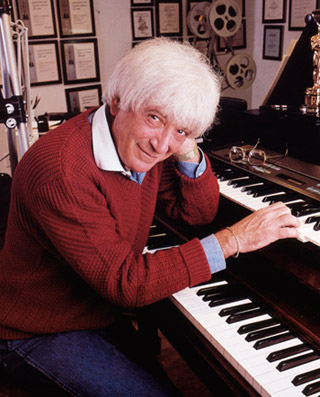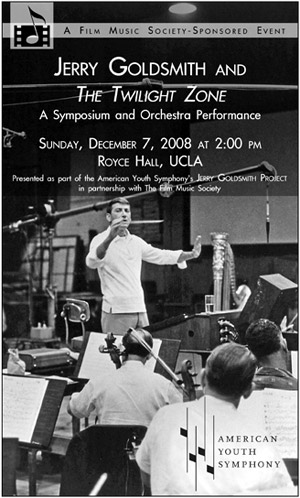

  |
|
|
||||||||||||||||||||||
|
FMS FEATURE... December 11, 2008 Jerry Goldsmith Revisited Symposium and concert honors legacy of revered film composer 
It marked the beginning of the three-year Jerry Goldsmith Project, a partnership between the AYS – one of the nation's leading orchestras of pre-professional young musicians – and The Film Music Society, a non-profit formed by industry professionals to preserve film and television music. The project is designed to explore the film and television career of one of the most respected composers ever to work in American film. Newman serves as president of both organizations. More than 1,100 turned out for Sunday night's AYS concert, the second half of which was an all-Goldsmith affair. Newman conducted the 94-member orchestra in five pieces from the composer's 1965-70 output: A Patch of Blue (1965), The Blue Max (1965), The Sand Pebbles (1966), Planet of the Apes (1968) and Patton (1970). The three-movement Apes suite and "First Flight" from Blue Max were drawn from Goldsmith's own concert arrangements, although Newman modified Apes slightly to reflect more of the composer's original film version. The nine-minute Patch of Blue, ten-minute Patton and 13-minute Sand Pebbles suites were newly assembled by Newman from Goldsmith's original sketches and scores. Four of the five were nominated for Academy Awards. Featured on A Patch of Blue was the harmonica soloist on the original film score, Tommy Morgan. Members of Goldsmith's family, including his wife Carol and sons Joel and Aaron, were on hand for the event. Film-music historian Jon Burlingame was the host. The evening concert also featured AYS music director Alexander Treger conducting music of Samuel Barber and John Corigliano, with violin soloist (and former AYS musician) Elizabeth Pitcairn. AYS executive director Janneke Straub introduced the concert. On Sunday afternoon, Royce Hall was also the site for a two-hour exploration of Goldsmith's music for the classic television series The Twilight Zone. Clips were screened from three of Goldsmith's scores ("Nervous Man in a Four Dollar Room," "Dust" and "Back There") as well as video of Goldsmith himself talking about his early work at CBS and with Twilight Zone creator Rod Serling (on Climax and Playhouse 90). Burlingame served as moderator for a panel of five experts: Twilight Zone Companion author Marc Scott Zicree, Varese Sarabande Records producer Robert Townson, composer Michael Lloyd and two composers who, like Goldsmith, wrote music for the original Twilight Zone, Robert Drasnin and Tommy Morgan. Morgan also played harmonica for Goldsmith on his scores for "Dust" and "Big Tall Wish." Drasnin was musical director on the 1980s version of Twilight Zone. All talked about Goldsmith's advanced musical approach to the fantasy series and shared anecdotes about working with him through the years. The highlight of the afternoon was Newman conducting 25 AYS musicians in a live-to-picture performance of Goldsmith's most famous Twilight Zone episode: "The Invaders," featuring Agnes Moorehead as an old farm woman battling tiny, apparently malevolent, astronauts who have landed in a flying saucer.  Approximately 300 people attended the afternoon event which, along with the evening concert, was free to the public. The "Invaders" performance was repeated Monday morning for an audience of approximately 1,100 school children from throughout the Los Angeles Unified School District, sponsored by UCLA Live's Design for Sharing outreach program. The Jerry Goldsmith Project will continue in 2009 and 2010 with explorations of Goldsmith's career in the 1970s and beyond. An Oscar and five-time Emmy winner, Goldsmith died of cancer in 2004 but remains one of the most admired composers in movie-music history. |
Search
Past Features
Feature Archives
|